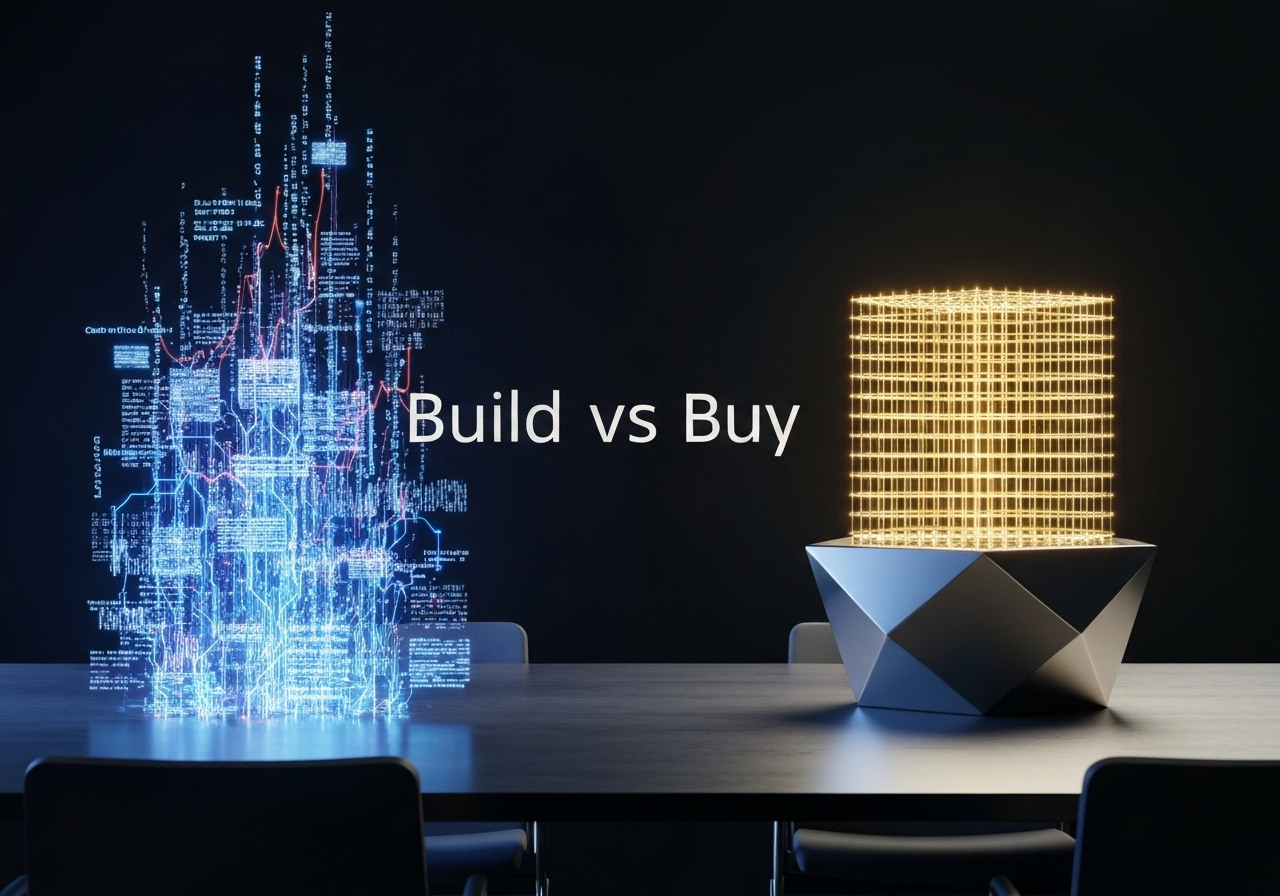The decision on whether to build a custom Artificial Intelligence (AI) solution or buy an off-the-shelf platform is the single most critical strategic choice facing enterprise leaders in the new digital economy. For businesses in Charlotte, NC, and across the US, navigating the complexities of AI requires more than just technical foresight; it demands a clear, governance-driven decision framework. This definitive guide addresses the core question of Build vs Buy for Enterprise AI in 2025, focusing on strategic value, compliance, and total cost of ownership (TCO).
The Strategic Imperative for AI Governance and Workflow Modernization
The era of experimental AI projects is over. Today, enterprise AI deployments are scrutinized by CFOs for concrete return on investment (ROI) and by boards for verifiable risk oversight. In the US, the regulatory context—driven by frameworks like the NIST AI Risk Management Framework (RMF) and sector-specific laws like HIPAA—puts immense pressure on companies to ensure their AI is ethical, transparent, and defensible. The fundamental business lesson often overlooked is that the choice between ‘Build’ and ‘Buy’ must be a governance decision first, and a technical one second.
Effective AI governance is the backbone of any successful deployment. It’s not enough to simply use AI; you must demonstrate a commitment to accountability, fairness, and security. Organizations must establish clear accountability frameworks and implement robust policies that extend through the entire AI lifecycle. Without a sound framework, even the most sophisticated AI solution — whether built or bought — risks regulatory failure, reputational damage, and financial penalties.
AI governance is built on core principles tech leaders must internalize:
- Transparency and Explainability: Understanding how AI decisions are reached is essential for auditing and building trust.
- Algorithmic Fairness: Systems must be regularly audited to ensure they do not perpetuate societal biases, especially in critical applications like hiring or lending.
- Accountability: Clear roles and responsibilities must be established for AI oversight, maintaining a human-in-the-loop for critical judgment.
- Data Security: AI systems relying on sensitive data (PHI, PII) demand strict data governance policies, often requiring data residency and security controls far beyond standard requirements.
The Definitive Decision Framework for Build vs Buy for Enterprise AI in 2025
For most enterprises, the decision to build or buy cannot be reduced to a simple cost comparison. It requires a structured, weighted scoring model that assesses the AI application across multiple strategic dimensions. This process transforms subjective debates into data-driven, audit-ready evidence for stakeholders.
Idea Forge Studios recommends a multi-dimensional framework to evaluate each AI use case:
| Dimension | Weight | Build Bias (High Score) | Buy Bias (High Score) |
|---|---|---|---|
| Strategic Differentiation | 15% | Core competitive advantage (e.g., proprietary underwriting logic) | Commodity productivity task (e.g., internal Q&A bot) |
| Data Sensitivity & Residency | 10% | PHI, PII, or trade secrets requiring strict internal control | Standard data not subject to immediate regulatory risk |
| Regulatory Exposure | 10% | Subject to SR 11-7, FDA, or deep SEC disclosure rules | Vendor provides certified compliance coverage (SOC 2, NIST RMF) |
| Customization Depth | 10% | Requires deep, workflow-specific logic or proprietary model finetuning | Off-the-shelf configuration meets 80% of needs |
| Time-to-Value | 10% | 6-12 month delivery window is acceptable | Must be deployed within weeks or one fiscal quarter |
The rule of thumb is clear: Build when the capability is your product moat. Buy when the primary driver is speed or established compliance coverage. For the majority of US enterprises, a blended model will be the pragmatic default.
When Competitive Moats Demand a Build Strategy: Agentic Coding and Custom CRM Development
In the digital landscape, a competitive moat is defined by unique operational capabilities that cannot be replicated by simply purchasing a subscription. This is precisely where a build strategy, driven by custom AI solutions and Agentic Workflows, becomes essential.
When is building a mandatory strategy?
- Strategic IP & Core Systems: If the AI is central to revenue generation (e.g., a unique risk scoring model, a novel claims process, or an innovative product recommendation engine for your e-commerce platform), it should be built. These systems are too valuable to rely on a vendor roadmap or proprietary API that could lead to vendor lock-in.
- Deep Integration into Legacy/Proprietary Systems: Many established businesses in Charlotte and beyond rely on highly customized Enterprise Resource Planning (ERP) or Customer Relationship Management (CRM) systems. Building custom AI agents using Python and FastAPI allows for seamless, secure integration directly into the control plane of these systems, something off-the-shelf tools often struggle to achieve.
- Regulatory Data Control: When dealing with strictly regulated data (HIPAA, banking records), keeping the model and data environment entirely in-house often simplifies compliance and provides the necessary assurance for board-level risk committees.
For high-value, domain-heavy applications, the long-term control over the technology stack, data, and security protocols justifies the initial build cost. Custom development allows for the creation of proprietary AI Agents—autonomous systems that can perform complex, multi-step tasks—which represent the next frontier of operational efficiency.
Accelerating AI Automation: The Role of N8N Workflows and Off-the-Shelf Platforms
For use cases that are more commoditized or where speed-to-value is paramount, buying or using low-code/no-code platforms for AI automation is the clear choice. These solutions are indispensable for modernizing internal workflows without the overhead of a full engineering team.
Platforms like n8n or Make shine when the goal is to orchestrate standard business processes, such as:
- Automated lead scoring and data enrichment.
- Syncing data between various SaaS tools (e.g., CRMs, marketing automation, Slack).
- Basic content generation or summarization tasks for internal use.
- Simple customer support ticket deflection.
The power of a tool like n8n is its ability to rapidly connect APIs and build resilient, automated workflows. By buying an established orchestration platform, businesses gain:
- Reduced Time-to-Market: Workflows can be deployed in weeks, not months.
- Lower Talent Cost: Automation can be managed by non-AI engineering staff.
- Immediate Scalability: Cloud-native solutions offer instant scaling for burst usage.
This approach is perfect for small to medium-sized businesses in Raleigh, NC, and elsewhere that are focused on immediate operational efficiency and marketing reach, such as enhancing social media marketing efforts through automated scheduling and performance tracking.
The Blended Operating Model: Integrating Buy for Governance and Building Core AI Workflows
For US enterprises in 2025, the most common and pragmatic strategy will be the blended model. This approach leverages the best of both worlds: buying proven vendor solutions for critical, compliance-heavy infrastructure and building custom layers where competitive advantage resides.
This model dictates buying the foundation for governance and compliance, while building the "last mile" of differentiation:
Buy for Compliance & Foundation
Vendor platforms excel at providing high-cost, non-differentiating services that are essential for governance and reliability:
- Governance & Audit Trails: Purchasing a dedicated AI governance platform — such as those focusing on MLOps and ethical standards — provides pre-built compliance artifacts and audit logs required by US regulators.
- Multi-Model Routing & Safety Layers: Using vendor solutions for multi-model routing, Role-Based Access Control (RBAC), Data Loss Prevention (DLP), and prompt safety filtering ensures a consistent, secure environment across all AI endpoints.
- Base Compute & Models: Subscribing to foundational models (GPT, Claude) and hosting infrastructure (cloud services) is almost always cheaper than running a proprietary cluster.
Build for Differentiation & Last-Mile Control
The in-house effort is then focused exclusively on proprietary IP:
- Custom Retrieval-Augmented Generation (RAG) Systems: Building your own vector stores and retrieval pipelines using proprietary company data is what makes AI uniquely smart for your business.
- Domain-Specific Tool Adapters: Custom-coding tool APIs for AI Agents to interact with internal legacy systems is essential for operationalizing complex, multi-step workflows.
- Proprietary Evaluation Datasets: Developing unique test datasets for hallucination and bias checks specific to your industry and customer base ensures the model operates correctly in your unique context.
This blend maximizes speed and compliance while safeguarding the company’s unique intellectual property (IP).
Beyond Sticker Price: Modeling 3-Year TCO for AI Initiatives and Database Cleanup
A frequent failure mode in the Build vs Buy calculation is the deceptive comparison of a one-year subscription cost against a multi-year build effort. Accurate decision-making requires modeling the Total Cost of Ownership (TCO) over a three-year horizon for a like-for-like comparison.
TCO for the Buy Strategy (36 months)
The cost of buying extends far beyond the initial subscription fee:
- Subscription and per-seat license fees.
- Token usage and API call fees (which can be highly unpredictable).
- Integration and change management costs, often overlooked in initial proposals.
- Vendor compliance costs (fees for SOC 2 reports, HIPAA BAA).
- The high cost of cloud egress and migration fees if the decision is made to switch vendors later.
TCO for the Build Strategy (36 months)
The cost of building is not just developer salaries. It includes the entire lifecycle:
- Internal engineering costs (MLOps, SRE, security engineers).
- Cloud compute (training, inference, continuous evaluation).
- Data preparation, cleaning, and continuous labeling.
- Mandatory compliance and audit costs (NIST RMF, penetration tests).
- Database cleanup and normalization efforts necessary to feed the model high-quality, structured data.
When modeling TCO, enterprises must recognize the long-term leverage of a build strategy. A proprietary AI platform (using Python, FastAPI, and robust orchestration) can be reused across multiple business units, amortizing the core infrastructure cost over several strategic initiatives. This reuse is a hidden benefit that often tips the TCO scale in favor of building core, differentiating assets.
Executive Checklist: Key Takeaways for Resilient AI Deployment and Control
The future of enterprise success hinges on a resilient AI deployment strategy that is both innovative and rigorously governed. Executives and business owners in Asheville, NC, Philadelphia, PA, and everywhere in between, must adopt a mindset that views AI not as a cost center, but as a strategic asset to be managed with control and foresight.
To ensure your organization’s AI initiatives are defensible, efficient, and aligned with strategic growth:
- Operationalize a Scored Decision Framework: Stop debating and start scoring. Use a weighted matrix (like the one above) to document the decision process for every major AI use case, ensuring the resulting artifacts satisfy regulatory and board scrutiny.
- Prioritize Governance as a Purchased Asset: When blending, buy vendor platforms that specialize in AI governance, auditing, and compliance attestations, thereby reducing the internal burden of proving adherence to frameworks like NIST AI RMF.
- Build the Uniqueness: Focus internal development resources on the "last mile" — the retrieval pipelines, custom agents, and proprietary evaluation datasets that create true business advantage. This is where your IP resides.
- Demand 3-Year TCO Modeling: Insist on a comprehensive, 36-month TCO model for all AI initiatives, explicitly accounting for compliance, cloud egress fees, and the internal costs of data hygiene and LLMOps.
- Ensure Portability: Negotiate vendor contracts with clear exit clauses and data portability agreements. This mitigates long-term lock-in and protects future flexibility in the rapidly evolving AI landscape.
By implementing a disciplined, governance-first strategy for the Build vs Buy for Enterprise AI in 2025 decision, leaders can accelerate innovation while building an AI infrastructure that is inherently resilient to risk and regulatory change.
Ready to Implement a Defensible AI Strategy?
The choice between building proprietary AI and buying a platform is your most critical strategic decision. Leverage our expertise to navigate governance, TCO, and custom development to build your competitive moat.
Or initiate contact directly:
(980) 322-4500 |
info@ideaforgestudios.com








Get Social